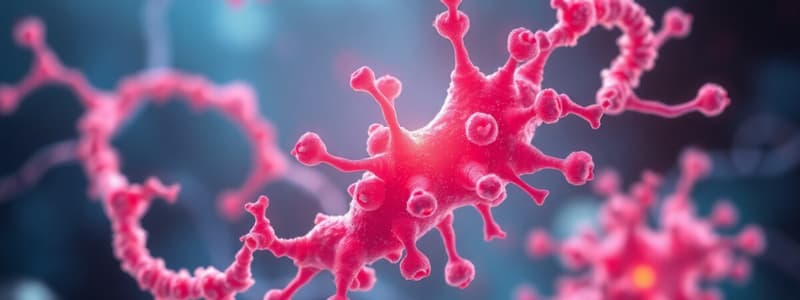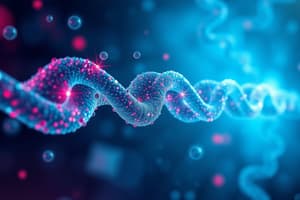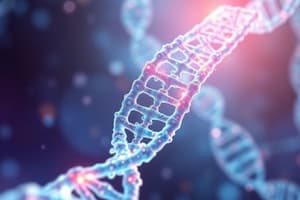Podcast
Questions and Answers
During which step of PCR does the Taq polymerase enzyme add bases to build a complementary DNA strand?
During which step of PCR does the Taq polymerase enzyme add bases to build a complementary DNA strand?
- Primer design
- Annealing
- Denaturing
- Extension (correct)
What is the primary ethical concern related to animal cloning?
What is the primary ethical concern related to animal cloning?
- The RSPCA's support for cloning as a means of preserving endangered species.
- Potential for enhanced animal welfare through genetic modification.
- The use of scientific procedures that may cause pain, suffering, and distress to the animals. (correct)
- Cloning leads to an increase in biodiversity.
In gel electrophoresis, what property of molecules determines their rate of migration through the gel?
In gel electrophoresis, what property of molecules determines their rate of migration through the gel?
- Concentration
- Size only
- Charge only
- Both size and charge (correct)
How do restriction enzymes facilitate the process of gel electrophoresis?
How do restriction enzymes facilitate the process of gel electrophoresis?
What is the primary purpose of recombinant DNA technology?
What is the primary purpose of recombinant DNA technology?
In a chi-square test, what does the null hypothesis generally state?
In a chi-square test, what does the null hypothesis generally state?
Which type of gene therapy involves modifying cells outside the body before transplanting them back into the patient?
Which type of gene therapy involves modifying cells outside the body before transplanting them back into the patient?
What is a significant ethical concern related to selective breeding practices?
What is a significant ethical concern related to selective breeding practices?
What is a potential environmental disadvantage associated with GMOs?
What is a potential environmental disadvantage associated with GMOs?
What is the primary mechanism by which CRISPR/Cas9 modifies DNA?
What is the primary mechanism by which CRISPR/Cas9 modifies DNA?
Flashcards
What is PCR?
What is PCR?
A technique used to create many copies of a specific DNA segment.
What are the steps of PCR?
What are the steps of PCR?
Denaturation, annealing, and extension. These steps repeat 20-40 times.
What is Somatic Cell Nuclear Transfer (SCNT)?
What is Somatic Cell Nuclear Transfer (SCNT)?
Transferring a somatic cell nucleus into an enucleated egg cell.
What is Gel Electrophoresis?
What is Gel Electrophoresis?
Signup and view all the flashcards
What are Restriction Enzymes?
What are Restriction Enzymes?
Signup and view all the flashcards
What is Bacterial Transformation?
What is Bacterial Transformation?
Signup and view all the flashcards
What is Recombinant DNA?
What is Recombinant DNA?
Signup and view all the flashcards
What is the Chi-Square test?
What is the Chi-Square test?
Signup and view all the flashcards
What is Gene Therapy?
What is Gene Therapy?
Signup and view all the flashcards
What are GMOs?
What are GMOs?
Signup and view all the flashcards
Study Notes
- PCR is a technique amplifying small DNA amounts into usable quantities for various applications like crime scene investigation
PCR Ingredients
- DNA template needing copying
- Primers
- DNA bases
- Taq polymerase to add bases
- Buffer
PCR Steps (Thermal Cycle)
- Repeated 20-40 times, doubling DNA each cycle
- Denaturing: Heating double-stranded DNA to 94-95°C separates it into single strands in 15-30 seconds
- Annealing: Lowering temperature to 50-65°C allows DNA primers to connect in 10-30 seconds, acting as the starting point for DNA synthesis
- Extension: Raising temperature to 72°C allows Taq polymerase adds bases
- Taq polymerase builds a complementary strand in 5' to 3' direction
- Takes about 1 minute for 1000 bases
Somatic Cell Nuclear Transfer (SCNT)
- SCNT involves transferring a somatic cell's nucleus into an enucleated egg cell's cytoplasm for organism cloning
- The cell is then placed in a surrogate
- Ethical Concerns: The cloning of animals raises ethical concerns of pain, suffering, and distress. Human cloning raises issues of safety, impact on family dynamics, and commodification
SCNT Steps
- Obtain a somatic cell and oocyte (egg cell) from the organism to be cloned
- Nucleus and genetic material are removed from oocyte with a micropipette
- Somatic cell nucleus is transferred to the oocyte
- The cell is stimulated with chemical or electrical pulse while put into surrogate for embryonic processes
- can be cultured in a lab setting
Gel Electrophoresis
- Technique separating molecules like DNA, RNA, or proteins by size and charge using an electric current through a gel
- Smaller molecules travel faster
- Used in crime scene identification
Gel Electrophoresis Steps
- Prepare DNA samples and buffer solution in box
- Load DNA sample with micropipette
- Run electrical current through buffer solution
- Observe bands and draw conclusions
Gel Electrophoresis Process
- Restriction enzymes break DNA into different-sized fragments, separated by electrical current
- Longer fragments stay closer to the start, smaller fragments travel towards the end
Restriction Enzymes
- Restriction enzymes, or "molecular scissors," are proteins from bacteria cutting DNA at specific nucleotide sequences
- Creates fragments with known sequences for genetic engineering
How Restriction Enzymes Work
- Cuts DNA between specific sequences, creating different sizes of DNA fragments for gel electrophoresis
- Ends can be sticky (staggered cut) or blunt (straight cut)
Bacterial Transformation
- Bacterial transformation involves a bacterial cell taking up foreign DNA and incorporating it into its genome
- May give new traits like antibiotic resistance
- Part of DNA cloning and creating recombinant DNA
- Used to make human proteins like insulin
Recombinant DNA
- Created by combining genetic material from multiple sources, enabling new gene combinations
Chi-Square Test
- Statistical test comparing observed results with expected results
- Determines if differences are due to chance or variable relationships
Creating Null Hypothesis for Chi-Square Test
- Null hypothesis states no relationship between variables
- Research hypothesis suggests a relationship between the variables
Chi-Square Steps
- Find expected value of offspring
- Plug values into formula: (observed - expected)² / expected
- Add the values
- Compare the p-value (result) to the critical value
- Reject the null hypothesis if value is lower, and if value is higher, then fail to reject
Gene Therapy
- All chi-square tests related to Gene Therapy have general null and research hypotheses that state no relationship, or relationship between the two variables being tested
Types of Gene Therapy
- In vivo: Corrected genes are delivered directly via IV or local delivery inside the body. ex: eye
- Ex vivo: Patient's cells are genetically modified outside the body in a lab and transplanted back in via vector to replace malfunctioning ones.
Selective Breeding
- Selective breeding (artificial selection) involves intentionally breeding plants/animals for desired traits
- Examples: increased crop yield or improved animal products
Ethical Concerns with Breeding
- Genetic engineering and selective breeding may violate animal rights by using them for human benefit
GMOs (Genetically Modified Organisms)
- GMOs are plants, animals, or microbes modified using genetic engineering
- Examples include crops like corn and fish like AquAdvantage salmon
Ethical Concerns about GMOs
- Health risks, environmental damage, impacts on farms, corporate dominance, and unnaturalness
Pros of GMO's
- Will help farmers make more of a profit
- crops will be bug / insect resistant
Cons of GMO's
- Allergic reactions, toxins, and increased herbicide use
- potential for antibiotic resistance, herbicide-resistant weeds and biodiversity loss
NGS (Next-Generation Sequencing)
- NGS (massively parallel/deep sequencing) is a DNA sequencing technology revolutionizing genomic research
- Entire human genome can be sequenced in a day
NGS Usage
- For understanding disease, improving medicine, and advancing research on cancer and rare conditions
Human Genome Project
- NGS stemmed from the earlier Human Genome Project
- Project took 32 years
Sanger Sequencing
- Fast, cost-effective sequencing method for small targeted genome regions
- Used to validate results from massively parallel sequencing and certain single-gene assays
How Sanger Sequencing Works
- Automated process: a computer reads each band that is fluorescing through an emitted light
- Steps: denaturing dsDNA, multiplying segment copies, attaching primer, adding polymerase solutions, amplifying and denaturing chains, electrophoreses solution
CRISPR
- Editing technology modifying DNA by cutting, inserting DNA sequences, adapted from bacterial defense system
CRISPR/Cas9
- Cuts DNA at specific location, deleting/inserting sequences, changing single DNA base, pieces of chromosomes, or gene expression
- Modifies point DNA sequences
- After observing bacteria, Scientists used bacteria's attacking mechanisms of deleting through Cas9 enzyme
Synthetic Biology
- Designs/builds new biological systems/redesigns existing ones, using DNA-encoded components for purposes like medicine/biofuels
Synthetic Biology Solutions
- Offers solutions for agriculture, medicine, and industry
- E.g., addressing food security, healthcare challenges, and sustainable production through gene editing and metabolic engineering
Transgenic Organisms
- Organism/cell with genome altered by introducing foreign DNA from another species artificially for research
Example of Transgenic Organisms
- Golden rice (genetically modified) engineered to reduce vitamin deficiency deaths in poor countries
- Created by mixing with corn and dirt bacteria that survive because of the vitamins they obtain, helping prevent disease.
DNA Fingerprinting
- Laboratory technique analyzing individual variations in DNA to create genetic profile
- Can then be used for indentification and forensics
Uses of DNA Fingerprinting
- Criminal investigations, forensics, and paternity testing
Studying That Suits You
Use AI to generate personalized quizzes and flashcards to suit your learning preferences.




